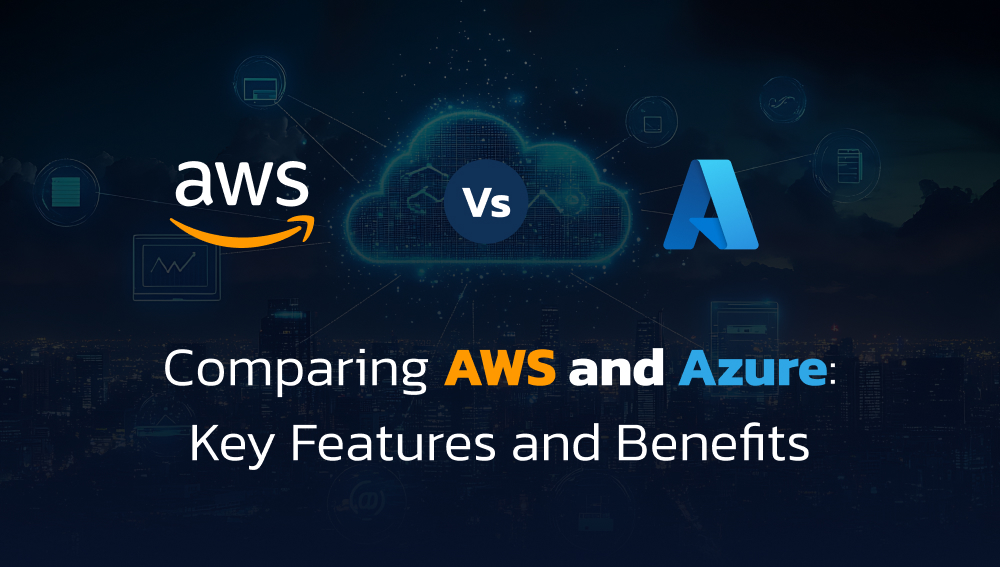
“The cloud is democracy.” – Marc Benioff, CEO of Salesforce.
Rightly said, the statement above captures the true essence of why cloud platforms have undergone mainstream adoption-all in good spirits. They enable you (whether you own a startup or an enterprise) to test your strategies in no time and with relatively less money. AWS and Azure are the leading cloud service providers, among others including Google Cloud Platform, Alibaba Cloud, and IBM Cloud. In this piece, we’ll explore the leading two.
Both cloud service platforms share a similar core- offering flexible auto-scaling, pay-as-you-go pricing, comprehensive security management, and powerful ML tools for big data analytics. Yet, despite these commonalities, the subtle differences in their features and ecosystems can make one platform more suitable for your specific needs than the other. Are you also caught in the middle, unsure which cloud service is right for your business? If so, this detailed AWS vs Azure guide will help you cut through the confusion.
AWS vs Azure: The Origins
Amazon Web Services
Today, AWS reigns as a leading force in the cloud industry, having evolved from Amazon’s internal infrastructure since its launch in 2006. It was originally built to help Amazon manage its growing eCommerce business more efficiently. Over time, this internal infrastructure evolved, adding advanced cloud capabilities that were soon offered to other businesses. With its early start in the market, AWS has built a strong, global network, delivering a wide range of services and tools that support businesses of all sizes.


Microsoft Azure
Just a few years later, Microsoft’s Azure made its debut in 2010. It was initially revealed at the Professional Developers Conference (PDC) by the name “Project Red Dog.” The platform aimed to build on the company’s connections with enterprise clients through an extensive software ecosystem. The resulting infrastructure easily integrated with other familiar Microsoft products like Windows and SQL Servers, making it a preferred choice for businesses already relying on such tools.
AWS vs Azure: Market Share
Maintaining its position as a front-runner since its early days, AWS continues to lead the cloud infrastructure market. As of the first quarter of 2024, AWS held a 31 percent share.

On the other hand, Microsoft Azure, being a primary competitor, steadily gained ground in the last two quarters (as visible in the infographic above). Its market share reached a record high of 25 percent in Q1 2024, highlighting Microsoft’s growing influence in the cloud computing space.
AWS vs Azure: Features
Let’s see how both cloud platforms differ in their services and features.
1. Computing Power: Provisioning and Usage
AWS offers computing resources through a variety of virtual servers called EC2 (elastic compute cloud) instances. These instances are highly customizable, meaning they can be configured for varying processing power, memory, or graphics. This enables users to easily scale their computing resources up or down depending on demand, helping them optimize costs by only paying for what is used. AWS also offers a serverless computing option with AWS Lambda, where you don’t have to manage any servers, and you’re only charged for the time your code runs.
On the other hand, Azure provides computing resources through virtual machines (VMs) provided by a virtual hard disc (VHD). Users can make adjustments to the number of VMs they use or set up automatic adjustments through VM Scale Sets, a feature that ensures consistency in performance by automatically adjusting compute resources. Azure also offers a serverless option through Azure Functions- a Lambda equivalent.
2. Storage Solutions
AWS offers a variety of storage options, allowing organizations to choose what works best and fits their budget. Here are the key storage services provided by AWS:
- Amazon S3: A popular choice for storing and retrieving large amounts of data, with various cost-saving options depending on data access frequency.
- Elastic Block Store (EBS): High-performance block storage for quick data access.
- Amazon Elastic File System (EFS): A fully managed service for managing shared file storage, suitable for applications needing scalable file storage solutions.
Azure also provides a range of flexible storage services, including:
- Azure Blob Storage: For storing unstructured data like documents and media files, with different tiers available to optimize costs.
- Azure Managed Disks: Reliable block storage for applications requiring high performance and durability.
- Azure Files: A managed file-sharing service used to access files via the SMB protocol to share files across multiple systems.
- Azure Elastic SAN: Block storage for mission-critical applications, consolidating multiple storage accounts into a single, cloud-native storage area.
- Azure Data Lake Storage: For big data analytics, a scalable solution for storing and analyzing large datasets.
Both their storage solutions are secure and can be configured for specific needs. AWS is ideal for flexible storage, especially for object and file storage, while Azure’s storage options are suitable for mission-critical or specific applications, mostly in hybrid cloud environments.
3. Documentation
Being a pioneer in the industry, AWS offers extensive documentation that covers every aspect of its services in detail, which is beneficial for users with technical background. However, for beginners, the vast amount of information may be overwhelming, requiring a steep learning curve.
On the other hand, Azure’s documentation is well-organized and easier to follow, especially if you’re familiar with Microsoft products. It has everything, from step-by-step guides to video tutorials, making it more accessible for new users.
4. Networking and Content Delivery
AWS offers numerous networking and content delivery options for secure cloud operations:
- Amazon Virtual Private Cloud (VPC): Private networks within the AWS cloud, offering a secure and scalable environment for their applications and data.
- AWS Direct Connect: Provides a dedicated, private connection between a company’s data center and AWS for smoother data transfers.
- Elastic Load Balancing: Distributes incoming traffic across multiple servers to maintain smooth performance for applications with varying loads.
- AWS CloudFront: Speeds up content delivery by caching it at various locations around the world.
Content delivery and networking options with Azure:
- Azure Virtual Network: Private networks within the Azure cloud.
- Azure ExpressRoute: Private, high-speed connections between a company’s on-premises infrastructure and the Azure cloud.
- Azure Load Balancer: Distributes incoming traffic across multiple servers to ensure consistent performance and to handle varying workloads efficiently.
- Azure CDN: Similar to AWS CloudFront, Azure’s CDN accelerates the delivery of content to users around the world.
Both of them offer nearly similar, reliable, and secure networking and content delivery options. The ultimate choice between the two largely depends on your organization’s preference and existing tech stack.
5. Database Support
Both AWS and Azure offer support for relational as well as non-relational databases.
AWS
- Amazon RDS
- Amazon Aurora
- Amazon DynamoDB
- Amazon DocumentDB
- Amazon ElastiCache
- Amazon Neptune
- Amazon Timestream
- Amazon Quantum Ledger Database (QLDB)
Azure
- Azure SQL Database
- Azure Cosmos DB
- Azure Database for MySQL, PostgreSQL, and MariaDB
- Azure Synapse Analytics
6. Machine Learning and AI
Both cloud providers offer comprehensive AI and ML capabilities through various services and tools.
AWS
- Amazon SageMaker: A fully managed service for building, training, and deploying machine learning models.
- Amazon Rekognition: A service for image and video analysis, including object detection and facial recognition.
- Amazon Polly: A text-to-speech service that converts text into lifelike speech.
- Amazon Lex: A service for building conversational interfaces and chatbots.
- Amazon Translate: A neural machine translation service for translating text between languages.
- Amazon Transcribe: An automatic speech recognition (ASR) service for converting speech to text.
- Amazon Forecast: A time-series forecasting service for generating accurate forecasts.
- AWS DeepLens: A deep learning-enabled video camera for developers to run deep learning models locally on the device.
- AWS DeepRacer: A fully autonomous 1/18th scale race car designed to test reinforcement learning models.
- Amazon Kendra: An intelligent search service powered by machine learning.
- Amazon Textract: A service that automatically extracts text and data from scanned documents.
- Amazon Augmented AI (A2I): A service that provides a workflow for human review of machine learning predictions.
Azure
- Azure Machine Learning: A cloud-based environment for building, training, and deploying machine learning models.
- Azure Cognitive Services: A collection of APIs for building intelligent applications.
- Azure Bot Services: Platform for building and deploying chatbots.
- Azure Synapse Analytics: An ML-based analytics service combining big data and data warehousing.
- Azure Databricks: An Apache Spark-based analytics data science platform.
- Azure HDInsight: A cloud-based service that provides big data analytics using open-source frameworks like Hadoop, Spark, and Kafka, integrated with machine learning.
- Azure Cognitive Search: A fully managed search service that incorporates AI to improve search results and discovery.
- Azure Percept: A platform for building and deploying edge AI solutions, including vision and audio capabilities.
- Azure Automated ML: A service that automatically trains and tunes machine learning models to achieve the best performance.
- Azure OpenAI Service: Provides access to OpenAI’s powerful models for tasks like language understanding, text generation, and more.
- Azure Batch AI: A platform for training deep learning and AI models using GPU-accelerated virtual machines.
- Azure Data Science Virtual Machines: Pre-configured VMs for data science and AI development, supporting popular frameworks like TensorFlow, PyTorch, and Scikit-Learn.
7. User Experience and Management Tools
AWS Management Console offers a vast range of services through a single, user-friendly interface, but it may feel overwhelming to new users due to the sheer number of available options.
Azure’s Portal is straightforward and integrates well with other Microsoft products, making it easy for users who are already familiar with Microsoft tools. It simplifies managing resources, especially for those already using products like Windows Server or Office 365.
8. Security and Compliance
AWS offers a comprehensive set of security tools to protect cloud resources and data.
- Identity and Access Management (IAM) service to control access to resources
- Amazon GuardDuty for intelligent monitoring
- Security Hub for a centralized view of security compliance
- AWS Shield to protect against DDoS attacks
- AWS WAF (Web Application Firewall) to filter web traffic for malicious access
- Amazon Macie to discover sensitive data
- AWS CloudHSM-a hardware-based solution for encryption key management
Azure also provides robust security and compliance tools, deeply integrated with its cloud services.
- Azure Security Center for unified security management across Azure environments
- Microsoft Entra (formerly Azure AD) for identity and access management
- Microsoft Sentinel for security analytics and threat detection
- Microsoft Defender for cloud workloads
- Azure Key Vault for secure storage of secrets like passwords and certificates
- Microsoft Purview for data discovery and loss prevention
9. Cost and Pricing
AWS Pricing
AWS uses a pay-as-you-go pricing model that is billed on an hourly basis. You can choose from multiple purchasing options to manage costs:
- On-Demand: Pay only for the resources used without any upfront commitment.
- Spot Instances: Bid for unused capacity at lower rates, which is ideal for flexible and interruptible workloads.
- Reserved Instances: Reserve instances for a one- or three-year term to receive significant discounts.
Azure Pricing
Azure also follows a pay-as-you-go model but is billed on a per-minute basis, providing more granular pricing than AWS. This model allows you to only pay for the exact minutes used. However, due to this structure, it can sometimes be more expensive than AWS for larger instance configurations.
You can also review pricing for individual services or use their pricing calculators to get a more accurate estimate of your costs.
10. Support
AWS offers a variety of support plans for unique needs and budgets. Options range from basic, free support to more extensive plans with 24/7 technical assistance, a dedicated account manager, and personalized guidance. You can start slow with free-tier versions and add to it if required.
Azure also provides multiple support plans, which can be integrated with your existing Microsoft support agreements. Like AWS’, options range from basic self-help resources to full, round-the-clock support with technical account management.
AWS vs Azure: Pros and Cons
Being the top two industry-leading cloud providers, both AWS and Azure offer unparalleled services and support. However, because of differences in provisioning, usage structures, pricing models, and unique features, AWS and Azure are better suited for certain scenarios over others. Let’s explore when each platform might be the best choice.
When AWS Works Better
- You have Linux-based applications: AWS offers Amazon Linux 2, a secure and high-performance OS for EC2 instances.
- You need managed SQL databases: AWS’s Amazon RDS and Amazon Aurora are excellent for running MySQL and PostgreSQL databases in the cloud.
- You require more intricate cloud storage options: Options like AWS S3 allow you to assign different performance and cost settings to individual storage objects.
- You need customizable pricing options: AWS offers various pricing models, such as on-demand, reserved, and spot instances, allowing you to optimize your cloud spending.
- You need better global reach: AWS has an extensive global network of data centers with good geographical coverage and low-latency access for their users
When Not to Choose AWS
AWS might not be the ideal choice if you prefer a cloud platform with a higher level of built-in integration and pre-configured tools, as it requires more configuration and management effort.
When Azure Works Better
- You are already invested in Microsoft products: Azure easily integrates with existing Microsoft tools like Windows, Office 365, and Dynamics 365.
- You run SAP applications: Azure provides strong support and a straightforward migration path for SAP applications, ensuring smooth transitions and reliable performance.
- You need high-performance, scalable NoSQL databases: Azure databases like Cosmos DB offers robust support for scalable NoSQL databases with multi-region data distribution, ideal for applications requiring low-latency data access.
- You focus on low-code development: Azure’s Power Platform facilitates rapid application development and workflow automation, perfect for teams looking to build solutions quickly without extensive coding.
- You want simplified cloud management: Azure provides a user-friendly interface and easy integration with Microsoft tools, simplifying the management of cloud services and reducing the learning curve for users familiar with the Microsoft ecosystem.
When Not to Choose Azure
Avoid going for Azure if your organization heavily relies on open-source technologies outside the Microsoft ecosystem, as Azure might not provide the same level of flexibility and support for non-Microsoft environments.
AWS vs Azure: Making the Final Decision
Deciding between Azure and AWS ultimately comes down to your specific needs and technical preferences. Think about your team’s expertise and current infrastructure-shifting to a new cloud platform could mean needing specialized help and making significant changes to your setup. Even if your team can handle the transition, there might be a learning curve and some resistance to change.
You should also weigh whether you need a platform that integrates seamlessly with Windows or one that offers more flexibility with open-source technologies and APIs. And don’t overlook AWS vs Azure pricing-AWS’s flexible billing model might save you money for fluctuating workloads, while Azure’s per-minute billing could end up being more expensive if not closely managed.
If you’re finding it challenging to make the right call, speak to our cloud experts. After analyzing your requirements, tech infrastructure, and computing goals, they can suggest the best course of action. Why risk making the wrong choice when you can get expert advice?





